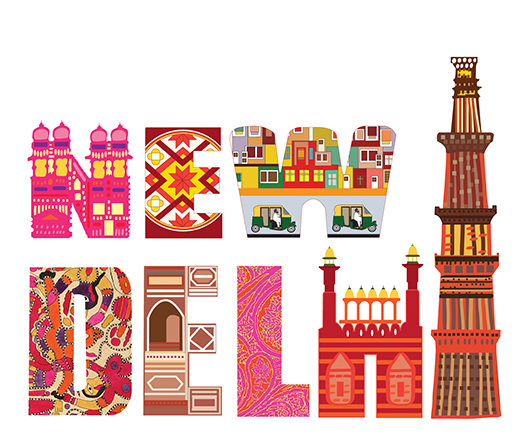About Delhi / New Delhi
New Delhi, the vibrant heart of India, pulsates with rich cultural heritage, modernity, and diversity. As India’s capital city, New Delhi stands as a testament to the nation’s past and future aspirations.
Steeped in history, New Delhi boasts magnificent monuments such as the iconic Red Fort, a UNESCO World Heritage site, and the impressive India Gate, a symbol of national pride. Its Mughal-era architecture, bustling markets like Chandni Chowk, and serene gardens like Lodhi Garden offer a glimpse into its storied past and bustling present.
Beyond its historical charm, New Delhi is a hub of commerce, politics, and culture. It houses numerous government institutions, international embassies, and corporate headquarters. The city’s thriving arts scene, vibrant nightlife, and culinary delights cater to every taste and preference.
New Delhi’s allure lies in its ability to blend tradition with modernity seamlessly. It welcomes visitors with warmth, offering a multitude of experiences from exploring ancient monuments to indulging in contemporary shopping malls and dining at world-class restaurants.
Whether you’re drawn to its historical landmarks, bustling markets, or dynamic cultural scene, New Delhi promises an unforgettable experience that captures the essence of India’s past, present, and future aspirations.
Spread over an area of 1483 Sq. Km and 216 Meters above sea level, the city shares its boundary with two states – Haryana and Uttar Pradesh.

Education in Delhi / New Delhi
Education in Delhi, particularly in New Delhi, reflects a rich tapestry of academic excellence, diversity, and innovation. As India’s capital region, New Delhi boasts a robust educational infrastructure that caters to a wide spectrum of learners, from primary education to higher studies and beyond.
Primary and Secondary Education: New Delhi is home to numerous public and private schools renowned for their academic rigor and holistic development approaches. Institutions such as Delhi Public School, Modern School, and The Shri Ram School are celebrated for their comprehensive curriculum, extracurricular activities, and emphasis on character building.
Higher Education: The city hosts some of India’s most prestigious universities and colleges. The University of Delhi (DU), established in 1922, is a prominent institution offering a wide array of undergraduate, postgraduate, and doctoral programs across disciplines. Jawaharlal Nehru University (JNU), renowned for its research and liberal arts education, is another cornerstone of higher education in New Delhi.
Technical and Professional Education: New Delhi is also a hub for technical and professional education institutions. The Indian Institutes of Technology (IIT Delhi), National Institute of Fashion Technology (NIFT), and All India Institute of Medical Sciences (AIIMS) are renowned nationally and internationally for their specialized programs and cutting-edge research facilities.
Based on the 2011 census data for Delhi’s literacy rates:
- Delhi’s overall literacy rate is 86.3%.
- The literacy rate among males is 91.0%.
- The literacy rate among females is 80.9%.
These figures indicate the percentage of people aged 7 and above who can read and write in Delhi, reflecting the educational attainment levels within the population at that time.
Delhi is considered a highly favorable market for student recruitment due to several key factors:
- Large Student Population: Delhi boasts a significant population of students across various educational levels, from primary to tertiary education. This includes students pursuing higher education in diverse fields such as engineering, medicine, humanities, and management.
- Education Hub: Delhi is home to some of India’s top educational institutions, including the University of Delhi, Jawaharlal Nehru University, and Indian Institute of Technology Delhi. These institutions attract students not only from Delhi but also from other parts of India and abroad, making it a diverse and competitive educational environment.
- Diversity and Demand: The city’s diverse population, consisting of residents from different states and countries, creates a demand for educational opportunities that cater to varied interests and backgrounds. This diversity enhances the appeal for institutions looking to recruit students with different cultural, linguistic, and academic profiles.
- Economic Center: Delhi serves as an economic hub with thriving sectors in information technology, finance, healthcare, and more. This economic prosperity often translates into higher disposable incomes among families, making them willing to invest in quality education for their children both domestically and internationally.
- Accessibility and Infrastructure: The city’s well-developed infrastructure, including transportation networks, educational facilities, and modern amenities, facilitates easier access and convenience for students and their families. This enhances the attractiveness of Delhi as a location for educational pursuits.
- Networking and Collaboration Opportunities: Delhi offers ample opportunities for networking and collaboration among educational institutions, industry partners, government bodies, and international organizations. Such collaborations can strengthen recruitment efforts by providing access to resources, expertise, and funding opportunities.
Overall, Delhi’s vibrant educational ecosystem, combined with its demographic diversity, economic strength, and infrastructure, positions it as a promising market for student recruitment initiatives across various educational sectors. Institutions looking to expand their student base can leverage these factors to effectively engage with prospective students and their families in the region.
Upcoming Education Fairs in New Delhi
Education Fair in New Delhi in May 2025
| Date | Day | Venue | City | Further Details |
| 11th May 2025 | Sunday | Hotel Le Meridien, Janpath | New Delhi | Education Fair Details |
- Exhibitor Registration: https://www.eduworldwideindia.com/spring/exhibitorregistration/
- Visitor Registration: https://www.eduworldwideindia.com/spring/visitorregistration/
Education Fair in New Delhi in November 2025
| Date | Day | Venue | City | Further Details |
| 23rd November 2025 | Sunday | Hotel Le Meridien, Janpath | New Delhi | Education Fair Details |
- Exhibitor Registration: https://www.eduworldwideindia.com/fall/exhibitorregistration/





